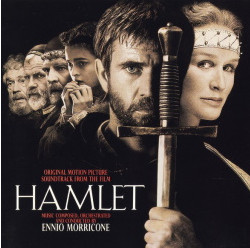主页--->m-comment-000--->mb-comment-012-121
|
电脑版 |
|||||||||||||||||||||||||||||||||||||||||||||||||||||||||||||||||||||||||
布罗克斯顿评说莫里康内 MB-012-121 |
||||||||||||||||||||||||||||||||||||||||||||||||||||||||||||||||||||||||||
HAMLET – Ennio Morricone |
||||||||||||||||||||||||||||||||||||||||||||||||||||||||||||||||||||||||||
FA9003 HAMLET – Ennio Morricone (哈姆雷特) |
||||||||||||||||||||||||||||||||||||||||||||||||||||||||||||||||||||||||||
作者 乔纳森·布罗克斯顿 (Jonathan Broxton) |
||||||||||||||||||||||||||||||||||||||||||||||||||||||||||||||||||||||||||
ENNIO MORRICONE 评论,第12部分 012-121 |
||||||||||||||||||||||||||||||||||||||||||||||||||||||||||||||||||||||||||
 |
||||||||||||||||||||||||||||||||||||||||||||||||||||||||||||||||||||||||||
哈姆雷特——埃尼奥·莫里康内Nov. 12, 2020
倒退30年 乔纳森·布罗克斯顿(Jonathan Broxton)的原始评论 多年来,威廉·莎士比亚的《哈姆雷特》被拍成电影和电视的版本有几十个,从劳伦斯·奥利维尔 1948 年的杰作,到托尼·理查森 1968 年根据他自己的伦敦舞台作品改编的版本,再到肯尼斯·布拉纳 1995 年发行的壮观奢华的未删节版本。1990 年,意大利导演佛朗哥·泽菲雷利 (Franco Zeffirelli) 发布了自己的版本,该版本通过让梅尔·吉布森 (Mel Gibson) 担任主角来直接吸引好莱坞的情感。当然,这个故事是一个经典的故事,丹麦名义上的王子密谋报复他的叔叔克劳狄斯,克劳狄斯在哈姆雷特的母亲格特鲁德的帮助下谋杀了他的兄弟国王——哈姆雷特的父亲。这是一个关于暴力、背叛、报复和疯狂的永恒故事,演员阵容壮观,包括格伦·克洛斯、艾伦·贝茨、保罗·斯科菲尔德、伊恩·霍尔姆和海伦娜·伯纳姆-卡特饰演不幸的奥菲莉亚。 佛朗哥·泽菲雷利(Franco Zeffirelli)之前曾涉足莎士比亚,1967年的《驯悍记》和1968年的《罗密欧与朱丽叶》,伟大的尼诺·罗塔(Nino Rota)创作了壮观的配乐,但泽菲雷利需要为哈姆雷特寻找新的音乐声音,因为罗塔已于1979年去世。也许不可避免的是,被选中的作曲家是他那一代最伟大的意大利作曲家埃尼奥·莫里康内,他在职业生涯的那个阶段坚定地成为电影音乐主流的一部分,并且主要为英语和好莱坞电影配乐。据我所知,这是莫里康内唯一一部莎士比亚改编作品,听到他对吟游诗人的演绎真是令人着迷。 总的来说,莫里康内完全直截了当地处理这个故事,专注于其中固有的戏剧和悲剧,没有真正提供任何不寻常的镜头或他偶尔的特殊解释。它完全是管弦乐的,尽管偶尔会有一些合唱的时刻,而且它主要集中在故事的黑暗上,这导致配乐有时会让人感到有点沉闷和沮丧。它在主题上也不是特别强烈,这对莫里康内来说是不寻常的。哈姆雷特、他注定要失败的爱情奥菲莉亚以及“疯狂”的一般概念都有反复出现的主题,但没有一个真正像莫里康内最好的主题那样坚持自己,相反,它们似乎满足于生活在大部分配乐的阴暗阴郁中。 《哈姆雷特》的主题是对弦乐的哀歌,旋律优雅而低沉,从中提琴到大提琴,并由小提琴的疲惫声伴奏。它完美地抓住了角色的本质——毕竟,他刚刚亲眼目睹了父亲被叔叔和母亲谋杀,并被父亲的鬼魂告知自己被谋杀,同时假装疯狂和拒绝爱情——所以从这个角度来看,这是一个成功。在音调上,它让我想起了莫里康内为《越战创伤》等电影写的优雅挽歌,并且在和弦进行中有点暗示巴伯的弦乐柔板。乐谱后面的第二个版本将主旋律表演从弦乐切换到双簧管,在我看来更具吸引力,尽管整首曲子充满了忧郁的情绪。后来,它在关键的“To Be or Not To Be”序列中的使用强调了莎士比亚独白中最有力的优雅和复杂。 同时,奥菲莉亚的主题提供了不同的旋律线和略有不同的乐器色彩,偏爱柔和的铜管、竖琴和轻盈的木管织体,以捕捉她最初更无忧无虑、俏皮的精神。然而,莫里康内明确表示,她的故事也是悲剧之一。当她对哈姆雷特的关怀被拒绝时,当他告诉她“带你去尼姑庵”时,当她在父亲波洛尼乌斯死于哈姆雷特之手后最终陷入疯狂时,莫里康内用越来越黑暗的和弦进行来说明这一点,以及以合唱声音为特色的时刻,最终是悲伤的抒情木管乐器。 乐谱的其余部分,如果没有突出两个主要主题中的任何一个,往往会依靠拉长的音调和变化的弦乐和弦,这创造了一种适当的悲剧和荒凉的情绪和氛围,但并没有真正在记忆中持续很长时间。任何经历过莫里康内任何更前卫的作品的人,尤其是他与Gruppo di Improvvisazione Nuova Consonanza合作创作的作品,都会听到对这种风格的回想。这一切都是相当简约和大气的。话虽如此,由于某种原因,有些线索是值得注意的。“The King Is Dead”是一首残酷的纹章呼唤和回应作品,为阴郁、回声的铜管乐曲,伴随着气势磅礴的教堂管风琴和锤击钢琴 ;它以某种方式设法将克劳狄斯的一系列富丽堂皇的宣传与哀叹哈姆雷特父亲的悲剧葬礼基调结合起来,这种想法的组合不应该协同工作,但以某种方式起作用。后来,《幽灵》是一首充满不和谐弦乐和木管乐器写作的险恶作品,再加上怪异的音效,包括合成器和人声,完美地捕捉了幽灵的可怕存在,以及它传递给哈姆雷特的复仇信息。 乐谱的中间部分包含了三段有趣的文艺复兴时期的场景,涉及玩家王、他的表演团,以及哈姆雷特利用他们的表演来揭示克劳狄斯的罪恶感的方式。莫里康内使用了那个时期典型的乐器(管子、小提琴、手鼓、七弦琴,以及听起来像长笛的东西),但以不寻常的方式安排它们——例如,“戏剧”相当扭曲,暗示了哈姆雷特的两面派和为克劳狄斯准备的不太微妙的信息。也许最直截了当的作品是“宴会”,这是一首活泼俏皮的舞蹈,旋律欢快。 从《哈姆雷特的疯狂》到最后的《穹顶》,在乐谱的最后十五分钟左右,莫里康内完全沉浸在这部作品的压倒性悲剧中,用鲜明的弦乐写作为哈姆雷特陷入疯狂和死亡谱曲,激动但又不知何故优雅,通过使用越来越刺耳的木管乐器和金属打击乐变得更加前卫。这种“疯狂主题”贯穿了《模拟疯狂》和《第二次疯狂》的大部分内容,也许在《壁橱》中达到了顶峰,突出了哈姆雷特意外杀死波洛尼乌斯的场景,并以莫里康内最死亡、最痛苦、最戏剧化的深刻写作为特色。莫里康内在这里写作中令人生畏的曲折和下降的音阶深深地借鉴了他的意大利giallo背景,产生了令人不安的效果,而其他人可能会想起霍华德·肖尔(Howard Shore)为《沉默的羔羊》等乐谱带来的沉思的管弦乐音调。 《哈姆雷特》是一个很难总结的乐谱。它写于那个时期的中期,其中包含了他最喜爱的许多作品——《教会》、《义胆雄心》、《天堂电影院》、《诺斯特罗莫》——但它听起来真的不像其中任何一部。旋律思想微妙而沉思,情感更偏向黑暗和忧郁,整件事具有深刻的严肃性,以至于许多人可能不会像与他那个时期的其他作品那样感受到与它相同的联系。就我个人而言,它从来都不是我最喜欢的莫里康内作品之一,但我喜欢它的地方在于莫里康内如何深入探讨推动故事的潜在心理问题,并为它们配乐,而不是不太复杂的作曲家可能关注的更明显的元素。《哈姆雷特》是一首很难让人爱的乐曲,它当然不是为了好玩而演奏的,但它对埃尼奥·莫里康内的智力方面有了深刻的了解,因此它值得一试。 从英国电影音乐商店购买《哈姆雷特》原声带 曲目列表:
片长:52分38秒 维珍唱片 30939 (1990) 音乐由埃尼奥·莫里康内作曲和指挥。埃尼奥·莫里康内的改编。由塞尔吉奥·马科图利和法比奥·文丘里录制和混音。由罗宾·克拉克(Robin Clarke)编辑。专辑由埃尼奥·莫里康内制作。 |
||||||||||||||||||||||||||||||||||||||||||||||||||||||||||||||||||||||||||
2020.11.12 |
||||||||||||||||||||||||||||||||||||||||||||||||||||||||||||||||||||||||||
|
| ||||||||||||||||||||||||||||||||||||||||||||||||||||||||||||||||||||||||||
以下是原文
| ||||||||||||||||||||||||||||||||||||||||||||||||||||||||||||||||||||||||||
ENNIO MORRICONE REVIEWS, Part 12-121 |
||||||||||||||||||||||||||||||||||||||||||||||||||||||||||||||||||||||||||
HAMLET – Ennio MorriconeNovember 12, 2020
THROWBACK THIRTY Original Review by Jonathan Broxton There have been literally dozens of versions of William Shakespeare’s Hamlet made for film and television over the years, ranging from Lawrence Olivier’s 1948 masterpiece, to Tony Richardson’s 1968 version based on his own London stage production, to Kenneth Branagh’s spectacularly lavish unabridged version released in 1995. In 1990 Italian director Franco Zeffirelli released his own version, which was made to appeal directly to Hollywood sensibilities through its casting of Mel Gibson in the title role. The story is, of course, a classic one, wherein the titular prince of Denmark plots revenge against his uncle Claudius, who murdered his brother the king – Hamlet’s father – with the help of Hamlet’s mother Gertrude. It’s a timeless story of violence, betrayal, retribution, and madness, and has a spectacular cast including Glenn Close, Alan Bates, Paul Scofield, Ian Holm, and Helena Bonham-Carter as the luckless Ophelia. Franco Zeffirelli’s previous forays into Shakespeare, with The Taming of the Shrew in 1967 and Romeo and Juliet in 1968, resulted in spectacular scores by the great Nino Rota, but Zeffirelli needed to find a new musical voice for Hamlet as Rota had died in 1979. Perhaps inevitably, the composer chosen was the greatest Italian composer of his generation, Ennio Morricone, who was firmly a part of the film music mainstream at that point in his career, and was scoring mostly English language and Hollywood films. As far as I can tell this is the only Shakespeare adaptation Morricone ever scored, and it’s fascinating to hear his take on the bard. By and large, Morricone approaches the story completely straightforwardly, concentrating on the drama and tragedy inherent in it all, without really offering any unusual takes or any of his occasionally idiosyncratic interpretations. It’s entirely orchestral, albeit with some occasional moments where a chorus is present, and it mostly focuses on the darkness of the story, which results in a score which can feel a little dour and depressing at times. It’s also not especially thematically strong, which is unusual for Morricone; there are recurring themes for Hamlet, for his doomed love Ophelia, and for the general concept of ‘madness,’ but none of them really assert themselves in the way that Morricone’s best themes do, instead seeming content to dwell in the murky gloom that characterizes most of the score. Hamlet’s theme is a lament for strings, with an elegant but downcast melody that moves from violas to cellos, and is backed by a weary-sounding wash of violins. It captures the essence of the character perfectly – after all, he has just seen his father murdered by his uncle and mother, and is being counseled by his father’s ghost to commit murder himself, all while feigning madness and rejecting love – so from that point of view, it’s a success. Tonally, it reminds me a little of the elegant dirges Morricone wrote for films such as Casualties of War, and it has a little hint of Barber’s Adagio for Strings in the chord progressions. The second version later in the score switches the lead melodic performance from strings to oboe, and is in my opinion more appealing, despite the melancholy emotion of the piece overall. Later, its use in the pivotal “To Be or Not To Be” sequence underscores that most powerful of Shakespearean soliloquies with grace and sophistication. Meanwhile, Ophelia’s theme offers a different melodic line, and slightly different instrumental colors, favoring soft brass, harps, and lightly darting woodwind textures to capture her initially more carefree, playful spirit. However, Morricone makes it clear that her story is one of tragedy too; when her caring advances towards Hamlet are rebuffed, when he tells her to ‘get thee to a nunnery,’ and when she eventually falls into a madness of her own following the death of her father Polonius at Hamlet’s hand, Morricone illustrates this with increasingly dark chord progressions, and moments featuring choral voices and, eventually, sadly lyrical woodwinds. A lot of the rest of the score, when not featuring any of the two main themes prominently, tends to rely on elongated tones and shifting string chords, which create a mood and an atmosphere of appropriate tragedy and desolation, but don’t really last long in the memory. Anyone who has experienced any of Morricone’s more avant-garde works, especially the pieces he wrote with Gruppo di Improvvisazione Nuova Consonanza, will hear callbacks to that style. It’s all quite minimalist and atmospheric. Having said that, some cues are notable for one reason or another. “The King Is Dead” is a brutally heraldic call-and-response piece for somber, echoing brass, accompanied by imposing church organs and hammered pianos; it somehow manages to combine an array of regal fanfares for Claudius with tragic funereal tones lamenting Hamlet’s father, a combination of ideas which should not work in tandem but somehow do. Later, “The Ghost” is a sinister piece full of dissonant string and woodwind writing, coupled with eerie sound effects, both synth-based and vocal, perfectly capturing both the spectre’s terrifying presence, and the vengeful message it passes on to Hamlet. The middle of the score contains a trio of interesting renaissance pastiches for the scenes involving the Player King, his acting troupe, and the way in which Hamlet uses their performance to reveal Claudius’s guilt. Morricone uses instrumentation typical of the period (pipes, fiddles, tambourines, lyres, and what sounds like a hurdy-gurdy) but arranges them in unusual ways – “The Play,” for example, is quite twisted, hinting at Hamlet’s duplicity and the none-too-subtle message intended for Claudius. Perhaps the most straightforward piece is “The Banquet,” a lively and playful dance with a jolly melodic core. The final fifteen minutes or so of the score, from “Hamlet’s Madness” through to the conclusive “The Vaults,” sees Morricone leaning fully into the overwhelming tragedy of the piece, scoring Hamlet’s descent into madness and death with stark writing for strings, agitated but also somehow graceful, and made all the more edgy through the use of increasingly shrill woodwinds and metallic percussion. This ‘madness motif’ continues through most of “Simulated Madness” and “Second Madness,” and perhaps reaches its peak in “The Closet ,” which underscores the scene where Hamlet accidentally kills Polonius, and features Morricone writing at his most deathly, most anguished, and most dramatically profound. The forbidding twists and descending scales in Morricone’s writing here draws deeply from his Italian giallo background, to unnerving effect, while others may be reminded of the brooding orchestral tones Howard Shore brought to scores like The Silence of the Lambs. Hamlet is a difficult score to summarize. It was written right in the middle of the period that contained so many of his most beloved works – The Mission, The Untouchables, Cinema Paradiso, Nostromo – but it really doesn’t sound like any of them. The melodic ideas are subtle and brooding, the emotions are much more skewed towards darkness and melancholy, and the whole thing has a profound seriousness to it, to the extent that many people will likely not feel the same sort of connection to it as they do to his other works of the period. Personally, it’s never been one of my Morricone favorites, but what I do like about it is how Morricone got deep into the underlying psychological issues that drive the story, and scored them rather than the more obvious elements that less sophisticated composers might focus on. Hamlet is a difficult score to love, and it’s certainly not one to play for fun, but it gives a strong insight into the intellectual side of Ennio Morricone, and for that it deserves a fair shot. Buy the Hamlet soundtrack from the Movie Music UK Store Track Listing:
Running Time: 52 minutes 38 seconds Virgin Records 30939 (1990) Music composed and conducted by Ennio Morricone. Orchestrations by Ennio Morricone. Recorded and mixed by Sergio Marcotulli and Fabio Venturi. Edited by Robin Clarke. Album produced by Ennio Morricone. |
||||||||||||||||||||||||||||||||||||||||||||||||||||||||||||||||||||||||||
Nov. 12, 2020 |
||||||||||||||||||||||||||||||||||||||||||||||||||||||||||||||||||||||||||
本站电影欣赏 |
||||||||||||||||||||||||||||||||||||||||||||||||||||||||||||||||||||||||||
在线音乐试听 |
||||||||||||||||||||||||||||||||||||||||||||||||||||||||||||||||||||||||||
|
||||||||||||||||||||||||||||||||||||||||||||||||||||||||||||||||||||||||||
 |
||||||||||||||||||||||||||||||||||||||||||||||||||||||||||||||||||||||||||
Jon 是一位电影音乐评论家和记者,自 1997 年以来一直担任全球最受欢迎的英语电影音乐网站之一 Movie Music UK 的编辑和首席评论员,并且是国际电影音乐评论家协会 (IFMCA) 的主席。在过去的 20多 年中,Jon 撰写了 3,000 多篇评论和文章,并进行了多次作曲家采访。在杂志刊物方面,乔恩曾为《电影配乐月刊》、《原声带杂志》和《电影音乐》等出版物撰写评论和文章,并为普罗米修斯唱片公司的两张经典 Basil Poledouris 配乐专辑《Amanda》和《Flyers / Fire on the Mountain》撰写了衬垫注释。他还为汤姆·胡佛 (Tom Hoover) 于 2011 年出版的《Soundtrack Nation: Interviews with Today's Top Professionals in Film, Videogame, and Television Scorering》一书撰写了一章。在1990年代后期,乔恩是伦敦皇家爱乐乐团的电影音乐顾问,并与他们合作拍摄了约翰·德布尼(John Debney)的音乐电影《相对价值》(Relative Values)和奥利弗·海斯(Oliver Heise)的音乐《佛陀的指环》(The Ring of the Buddha),以及与兰迪·纽曼(Randy Newman)合作的一系列音乐会。2012年,乔恩在波兰克拉科夫举行的第五届年度电影音乐节上担任“电影节学院”主席。他是作曲家和作词家协会的成员,该协会是作曲家、作词家和词曲作者从事电影、电视和多媒体工作的首要非营利组织。 |
||||||||||||||||||||||||||||||||||||||||||||||||||||||||||||||||||||||||||
2023.12.20 |
||||||||||||||||||||||||||||||||||||||||||||||||||||||||||||||||||||||||||
2023 手机版 |
||||||||||||||||||||||||||||||||||||||||||||||||||||||||||||||||||||||||||
|
||||||||||||||||||||||||||||||||||||||||||||||||||||||||||||||||||||||||||













